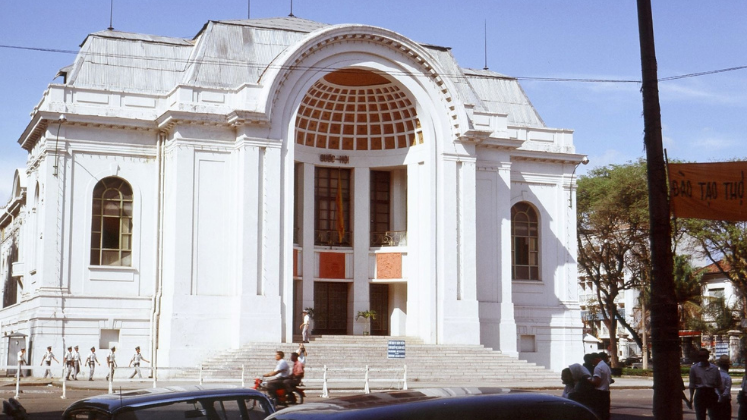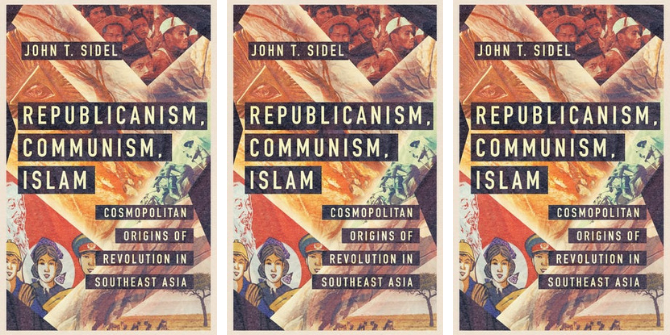Footprints of War by David Biggs offers readers an intriguing new perspective on the long history of military conflict and occupation in central Vietnam by integrating environmental perspectives with more traditional military and political histories. The book is a welcome contribution to creating a richer local history of central Vietnam in the context of the wider Wars for Indochina and is an inspiring application of robust historical research to solving modern environmental problems caused by war, writes Jon Formella.
This book review is published by the LSE Southeast Asia blog and LSE Review of Books blog as part of a collaborative series focusing on timely and important social science books from and about Southeast Asia.
Footprints of War: Militarized Landscapes in Vietnam. David Biggs. University of Washington Press. 2018.
 In recent years, the historiography of the Vietnam War has undergone a brilliant rejuvenation with fresh input from a new generation of scholars. One such work, Footprints of War: Militarized Landscapes in Vietnam by David Biggs, provides a new perspective on the history of conflict in Vietnam from the angle of environmental history by recognising the lasting impact of successive layers of military occupation upon the Vietnamese landscape. Utilising rich sources ranging from Vietnamese provincial library archives to US aerial intelligence and Geographic Information System (GIS) mapping, Biggs provides a valuable addition to the study of Vietnamese history in pursuing a multidimensional understanding of the legacy of successive conflicts’ ‘creative destruction’ in central Vietnam. While not devoid of certain controversial interpretations and methodological limitations, this book provides an inspiration for how robust historical research may be applied to solving modern issues caused by the scars of war.
In recent years, the historiography of the Vietnam War has undergone a brilliant rejuvenation with fresh input from a new generation of scholars. One such work, Footprints of War: Militarized Landscapes in Vietnam by David Biggs, provides a new perspective on the history of conflict in Vietnam from the angle of environmental history by recognising the lasting impact of successive layers of military occupation upon the Vietnamese landscape. Utilising rich sources ranging from Vietnamese provincial library archives to US aerial intelligence and Geographic Information System (GIS) mapping, Biggs provides a valuable addition to the study of Vietnamese history in pursuing a multidimensional understanding of the legacy of successive conflicts’ ‘creative destruction’ in central Vietnam. While not devoid of certain controversial interpretations and methodological limitations, this book provides an inspiration for how robust historical research may be applied to solving modern issues caused by the scars of war.
The longue durée perspective provided in the opening chapters of this work helps readers to position the more well-known French and American military operations in the long history of conflict and occupation in central Vietnam, centring on what is now the modern city Huế. In engaging with the history of central Vietnam from the early settlement of the Bronze Age Đông Sơn culture through the Nguyễn Dynasty (1802 to 1884) to the present Vietnamese regime, Biggs demonstrates how technological adaptations in combination with outside geopolitical forces both aided and frustrated attempts to exert military force on what is now central Vietnam. For instance, Biggs compellingly illustrates how the Vietnamese adaption of Ming China’s gunpowder technology and later Portuguese tactics enabled militaristic forays into previously impenetrable central Vietnamese territories by the Nguyễn lords starting from the 1400s.

Photo by Xiaofen P on Unsplash
While narrating successive attempts to pacify the region, Biggs also convincingly demonstrates remarkable historical continuities in the limits of military and political exertion due to the region’s unique environment and cultural resistance. Due to frustrated attempts at external control by the Nguyễn lords, for instance, the area around Huế became labelled by the Nguyễn as Ô Châu, or the ‘Terrible Lands’. Just as French, Republic of Vietnam and US forces would discover centuries later, military occupation of central Vietnam did not necessarily enable rulers such as the Nguyễn lords to remould the inhabitants of the region to their visions of civilised modernity. Sent by the Nguyễn court to spread state-sponsored Buddhism and thereby help to tame the peoples of Ô Châu, Chinese Buddhist monk Thích Đại Sán frustratingly remarked, ‘In some remote lands due to the isolation of high mountains and unfathomable seas, the greatest king could not send his troops to wipe out local conflicts […] As a result, residents […] ignored moral-cultural values.’ Such frustrated attempts at pacification would also be echoed by the later Saigon regime in its struggles to stifle insurgency through its strategic hamlet programme, as Biggs demonstrates. In this way, Biggs positions later French, Republic of Vietnam and US attempts to tame central Vietnam in a much longer history of frustrated governance.
Entering the modern era, Biggs’s examination of central Vietnam from the perspective of environmental and local history provides a highly welcome addition to the established historiography of the First and Second Indochina Wars. While macro-histories of the First Indochina War such as Fredrik Logevall’s Embers of War understandably examine the conflict by centring major campaigns in Tonkin, Biggs provides a valuable localised history of French military operations and Viet Minh resistance amidst the rugged landscape of central Vietnam. Especially helpful in understanding the First Indochina War from a wider perspective is Biggs’s application of French military intelligence and Viet Minh records to detail the 1953 French military’s Operation Camargue launched from the sea. Utilising aerial footage and GIS technology to complement familiar historical sources such as Bernard Fall’s Street Without Joy and Mai Nam Tràn’s The Narrow Strip of Land, Biggs provides an enriching new perspective to classic accounts of the First Indochina War and brings the reader to a grittier understanding of the French-Viet Minh conflict in the local environmental contours of central Vietnam.
Just as Biggs uses the local history of central Vietnam to expand the Tonkin-dominated historiography of the First Indochina War, another especially fascinating section of the book explores the history of central Vietnam as the newfound Republic of Vietnam (RVN) under the ruthless Ngô Đình Cấn attempts to pacify the region following the 1954 Geneva Accords. While much of the historiography of the ill-fated Republic of Vietnam (1954-75) regime centres on the rule of Ngô Đình Diệm and Nguyễn Văn Thiệu from the halls of power in Saigon, Biggs’s examination of Ngô Đình Cấn’s brutal attempts to establish a footing in the power vacuum in central Vietnam following both French and Viet Minh withdrawal in 1954 is a highlight of this work. Biggs’s detailing of Ngô Đình Cấn’s bloody stratagems to forge a regional empire through tenuous alliances among anti-communist and anti-French elements and through brutal purges amongst the chaotic landscape of central Vietnam is an especially enriching addition to the post-1954 history of Vietnam which often centres the rival power bases in Saigon and Hanoi. In this section, Biggs combines an explanation of local political forces with a layered presentation of local features such as a repurposed French bunker system through detailed maps to transport readers to the sites where brutal arrests, interrogations and executions of undesirables were carried out as a part of this network of repression.
Though Biggs’s study of interrelationship between the central Vietnamese landscape and attempts to exert governance rightly details both the violence and environmental brutality of pro-Saigon and US forces, it would seem that later sections of the book overlook essential nuances such as the unsavoury tactics on the part of communist forces in the region, especially during the 1968 Battle of Huế. While the detailed narration of the environmental destruction and violence is highly convincing, the author’s unbalanced attention away from the Viet Minh and communist forces suggests a subtle bias in positioning these as unbending defenders of both the people and the environment of central Vietnam. An especially problematic characterisation by Biggs states that the 1968 assault on Huế resulted in the ‘inadvertent killing of many civilians’. The author’s use of ‘inadvertent’ in this section mischaracterises events established by historical records from multiple sides witnessing the battle during which besieged communist forces willfully executed defenceless prisoners characterised as ‘lackeys’ by going house to house and killing males of military age. Despite citing evidence from Nhã Ca’s firsthand account of the Battle of Huế, Biggs’s one-sided characterisation of the battle and emphasis on civilian assistance to communist forces fail to highlight the antagonism and outright fear many local Vietnamese felt towards the communist forces articulated in Nhã Ca’s account as communist forces committed war crimes. This unbalanced examination towards the factions vying for control of the region in this later section is this work’s greatest flaw.
While the author’s repeated emphasis on the ‘aerial perspective’ from the powers seeking to control the region is convincing from the position of the French and US forces, the assertion that this ‘aerial perspective’ was formative in Vietnamese nationalist conceptualisations of the Vietnamese environment in the modern history of Vietnam is not convincingly backed by supporting primary source evidence in the book. While the term ‘aerial perspective’ is useful to describe the aerial intelligence collected by external forces and in a modern scholarly context, this terminology does not seem to be found among the Vietnamese nationalist actors mentioned in the work, communist or otherwise.
Overall, however, this new work by David Biggs is a great addition to the study of conflict in Vietnam, not only for its environmental history perspective but especially in telling the localised history of a region often de-centred in the historiography. Especially inspiring is Biggs’s application of his research and GIS toolkit not only to broaden understandings of history, but also to partner with locals and the Vietnamese government in removing harmful traces of the war such as chemical waste sites. Combining sturdy local history research with a layered environmental perspective and a strong altruistic component, this book will help readers understand both Vietnam and the possibilities for applied historical study from a fresh perspective.
Note: This review gives the views of the author, and not the position of the LSE Review of Books blog, the Saw Swee Hock Southeast Asia Centre or of the London School of Economics and Political Science.







